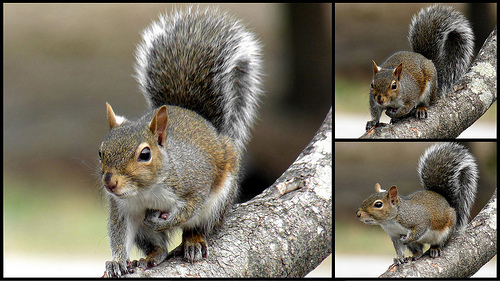State Mammal of North Carolina: Gray Squirrel
by Steven Case, 2012
NC Government & Heritage Library
See also: North Carolina State Symbols and Official Adoptions main page
See Also: Eastern Gray Squirrel
Related activity: State Mammal Coloring Sheet
 The NC General Assembly of 1969 named the Gray Squirrel as the official State Mammal (Session Laws, 1969, c. 1207).
The NC General Assembly of 1969 named the Gray Squirrel as the official State Mammal (Session Laws, 1969, c. 1207).
Selection as State Mammal
The bill was introduced by Rep. Basil Barr of Ashe County, who conducted a survey of school children to determine a favorite. Having noted that North Carolina already had an official bird, tree, flower, and shell, Barr proposed the squirrel as a state symbol, characterizing it as “courageous and thrifty” (quoted in the Statesville Record and Landmark, June 4, 1969, sec. 2 p. 1). The bill was introduced in the House on May 29th, passed a week later, and went on to the Senate, which approved it on June 30.
About the Gray Squirrel
First described in 1788, the squirrel contributed in its own small way to the survival of the North American colonies and the success of the Revolution. As an abundant game animal it provided a much needed food source, and some early chronicles suggested that the marksmanship necessary to successfully hunt such an elusive animal was a vital training ground for the citizen-soldiers who fought in the American Revolution and the War of 1812.
The squirrel is diurnal (that is, active during the day), and largely arboreal. Dens are in natural tree hollows or dreys (nests) made of twigs and branches. Being both adaptable and omnivorous, squirrels can flourish in hardwood forests, suburban woodlands, small parks, and even urban neighborhoods with shade trees.
The gray squirrel may be found in all 100 counties of the state. Its range extends from Florida to southern Canada, and west as far as the Great Plains. Though their diet consists mostly of nuts and seeds, gray squirrels will also eat tree buds, bark, fruit, fungi, insects, eggs, and occasionally even small birds. During the autumn, squirrels will “scatter hoard” nuts (that is, bury them in multiple locations as a food source for the winter), thus not only creating their own food cache, but also providing an ongoing means of reforestation, since many of the nuts they bury remain uneaten, and so have a chance to germinate. For more information, see Gray Squirrel.
Session Laws, 1969, c. 1207:
H. B. 1268 CHAPTER 1207
AN ACT TO ADOPT AN OFFICIAL STATE MAMMAL FOR THE STATE OF NORTH CAROLINA.
The General Assembly of North Carolina do enact:
Section 1. The Gray Squirrel (Sciurus carolinensis) is hereby adopted as the official State mammal of the State of North Carolina.
Sec. 2. All laws and clauses of laws in conflict with this Act are hereby repealed.
Sec. 3. This Act shall be in full force and effect from and after its ratification.
In the General Assembly read three times and ratified, this the 1st day of July, 1969.
References and additional resources:
Resources in libraries via Worldcat
IUCN Red List profile: https://www.iucnredlist.org/apps/redlist/details/42462/0
Smithsonian Profile: https://naturalhistory.si.edu
Smithsonian Wild picture gallery: http://emammal.si.edu
Animal Diversity Web profile (University of Michigan): https://animaldiversity.org/site/accounts/information/Sciurus_carolinensis.html
Profile from Discover Life: http://www.discoverlife.org/nh/tx/Vertebrata/Mammalia/Sciuridae/Sciurus/carolinensis/
Profile from Encyclopedia of Life: https://eol.org/pages/347685/entries/45632253/details
First description (in Latin) of Sciurus Carolinensis, Gmelin 1788 (13th ed of Systema Naturae): https://archive.org/details/carolilinnsys01linn/page/148/mode/2up?view=theater
Page mentioning squirrel hunting as training aid in Jackson and New Orleans (1854): https://archive.org/details/jacksonneworleans00walkrich/page/154/mode/2up?view=theater
Page mentioning squirrel hunting as training aid in Jackson: Symbol for an Age (1962): https://archive.org/details/andrewjacksonsym002452mbp/page/n49/mode/2up?view=theater
Image credits:
Sanderson, Virginia (Ginny). Squirrel triptych. 2011. Accessed Mar. 11, 2024. https://www.flickr.com/photos/vsanderson/5327618836/.
18 April 2012 | Case, Steven
 Listen to this entry
Listen to this entry